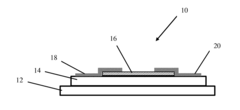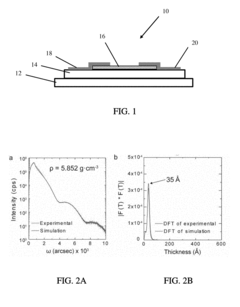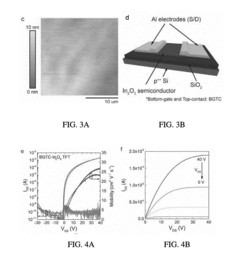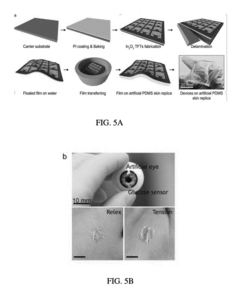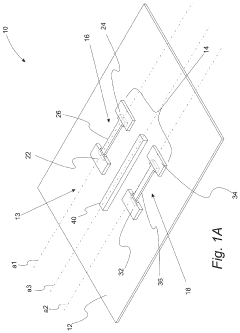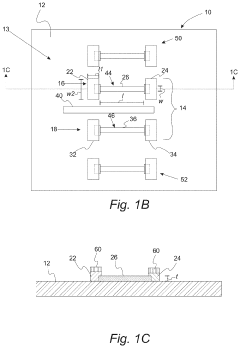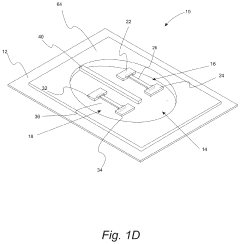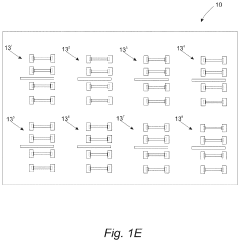Semiconductors in Wearable Biosensors: A Technical Review
OCT 24, 202510 MIN READ
Generate Your Research Report Instantly with AI Agent
Patsnap Eureka helps you evaluate technical feasibility & market potential.
Semiconductor Biosensor Evolution and Objectives
Semiconductor technology in biosensors has evolved significantly over the past several decades, transforming from simple electrical conductivity measurements to sophisticated integrated sensing platforms. The journey began in the 1960s with the development of the first ion-sensitive field-effect transistors (ISFETs), which demonstrated the potential of semiconductor materials for biological sensing applications. By the 1980s, these technologies had advanced to include enzyme-based biosensors that could detect specific biological molecules through electrochemical reactions on semiconductor surfaces.
The 1990s and early 2000s witnessed a paradigm shift with the miniaturization of semiconductor devices, enabling the first generation of wearable biosensors. These early devices were primarily focused on basic physiological monitoring such as heart rate and body temperature. The integration of CMOS (Complementary Metal-Oxide-Semiconductor) technology with biosensing elements marked a significant milestone, allowing for more complex signal processing and improved sensitivity.
Recent advancements have been driven by the convergence of semiconductor technology with nanotechnology, resulting in nanoscale biosensors capable of detecting biomarkers at previously unattainable concentrations. Materials such as silicon nanowires, graphene, and quantum dots have expanded the sensing capabilities while reducing power consumption and form factor. These innovations have enabled continuous, real-time monitoring of various health parameters, moving beyond episodic measurements to comprehensive health tracking.
The current technological landscape is characterized by the integration of multiple sensing modalities on a single semiconductor platform. Modern wearable biosensors incorporate not only electrochemical and optical sensing but also mechanical and thermal detection mechanisms, providing a more holistic view of physiological states. The development of flexible and stretchable semiconductor materials has further enhanced the wearability and user comfort of these devices.
Looking forward, the primary objectives for semiconductor-based wearable biosensors include achieving greater sensitivity and specificity while maintaining low power consumption and miniaturization. There is a growing emphasis on developing self-powered biosensors that can harvest energy from the human body or the environment. Additionally, improving the biocompatibility and long-term stability of semiconductor materials in contact with biological fluids remains a critical challenge.
Another key objective is the advancement of data processing capabilities directly on the sensor platform, known as edge computing, to reduce latency and enhance privacy. The integration of artificial intelligence algorithms with semiconductor biosensors aims to enable predictive analytics and personalized health insights. Ultimately, the goal is to create seamless, unobtrusive wearable biosensing systems that can continuously monitor health parameters and provide actionable information to users and healthcare providers.
The 1990s and early 2000s witnessed a paradigm shift with the miniaturization of semiconductor devices, enabling the first generation of wearable biosensors. These early devices were primarily focused on basic physiological monitoring such as heart rate and body temperature. The integration of CMOS (Complementary Metal-Oxide-Semiconductor) technology with biosensing elements marked a significant milestone, allowing for more complex signal processing and improved sensitivity.
Recent advancements have been driven by the convergence of semiconductor technology with nanotechnology, resulting in nanoscale biosensors capable of detecting biomarkers at previously unattainable concentrations. Materials such as silicon nanowires, graphene, and quantum dots have expanded the sensing capabilities while reducing power consumption and form factor. These innovations have enabled continuous, real-time monitoring of various health parameters, moving beyond episodic measurements to comprehensive health tracking.
The current technological landscape is characterized by the integration of multiple sensing modalities on a single semiconductor platform. Modern wearable biosensors incorporate not only electrochemical and optical sensing but also mechanical and thermal detection mechanisms, providing a more holistic view of physiological states. The development of flexible and stretchable semiconductor materials has further enhanced the wearability and user comfort of these devices.
Looking forward, the primary objectives for semiconductor-based wearable biosensors include achieving greater sensitivity and specificity while maintaining low power consumption and miniaturization. There is a growing emphasis on developing self-powered biosensors that can harvest energy from the human body or the environment. Additionally, improving the biocompatibility and long-term stability of semiconductor materials in contact with biological fluids remains a critical challenge.
Another key objective is the advancement of data processing capabilities directly on the sensor platform, known as edge computing, to reduce latency and enhance privacy. The integration of artificial intelligence algorithms with semiconductor biosensors aims to enable predictive analytics and personalized health insights. Ultimately, the goal is to create seamless, unobtrusive wearable biosensing systems that can continuously monitor health parameters and provide actionable information to users and healthcare providers.
Market Analysis for Wearable Biosensor Applications
The wearable biosensor market is experiencing unprecedented growth, driven by increasing health consciousness and the rising prevalence of chronic diseases requiring continuous monitoring. The global market for wearable biosensors was valued at approximately $13.2 billion in 2022 and is projected to reach $33.7 billion by 2027, representing a compound annual growth rate (CAGR) of 20.5%. This remarkable expansion reflects the growing integration of semiconductor technologies in healthcare applications.
Consumer healthcare represents the largest application segment, accounting for nearly 45% of the market share. This dominance stems from the widespread adoption of fitness trackers and smartwatches with integrated biosensing capabilities. Major players like Apple, Fitbit (Google), and Samsung have successfully commercialized devices that monitor heart rate, blood oxygen levels, and even perform electrocardiograms, creating a robust consumer ecosystem.
The medical and clinical applications segment, while currently smaller at approximately 30% of the market, is expected to grow at the fastest rate (23.8% CAGR) through 2027. This growth is fueled by the increasing acceptance of remote patient monitoring systems and the development of FDA-approved wearable diagnostic devices. Continuous glucose monitoring systems alone constitute a $4.2 billion market, with companies like Dexcom and Abbott leading innovation.
Sports and fitness applications represent about 20% of the market, with professional athletics and serious fitness enthusiasts driving demand for advanced performance metrics. The remaining market share is distributed across industrial safety, military, and veterinary applications, each with specialized requirements for semiconductor-based biosensors.
Geographically, North America dominates with 42% market share, followed by Europe (28%) and Asia-Pacific (24%). However, the Asia-Pacific region is projected to grow at the highest rate due to increasing healthcare expenditure, rising chronic disease prevalence, and expanding middle-class populations in China and India.
Key market drivers include the aging global population, increasing prevalence of chronic diseases, growing consumer interest in preventive healthcare, and technological advancements in semiconductor miniaturization. The COVID-19 pandemic has further accelerated market growth by highlighting the importance of remote health monitoring capabilities and creating new opportunities for biosensor applications in infectious disease detection and management.
Challenges facing market expansion include concerns about data privacy and security, regulatory hurdles for medical-grade devices, and the need for improved sensor accuracy and reliability. Additionally, battery life limitations and the high cost of advanced semiconductor components remain significant barriers to wider adoption in price-sensitive markets.
Consumer healthcare represents the largest application segment, accounting for nearly 45% of the market share. This dominance stems from the widespread adoption of fitness trackers and smartwatches with integrated biosensing capabilities. Major players like Apple, Fitbit (Google), and Samsung have successfully commercialized devices that monitor heart rate, blood oxygen levels, and even perform electrocardiograms, creating a robust consumer ecosystem.
The medical and clinical applications segment, while currently smaller at approximately 30% of the market, is expected to grow at the fastest rate (23.8% CAGR) through 2027. This growth is fueled by the increasing acceptance of remote patient monitoring systems and the development of FDA-approved wearable diagnostic devices. Continuous glucose monitoring systems alone constitute a $4.2 billion market, with companies like Dexcom and Abbott leading innovation.
Sports and fitness applications represent about 20% of the market, with professional athletics and serious fitness enthusiasts driving demand for advanced performance metrics. The remaining market share is distributed across industrial safety, military, and veterinary applications, each with specialized requirements for semiconductor-based biosensors.
Geographically, North America dominates with 42% market share, followed by Europe (28%) and Asia-Pacific (24%). However, the Asia-Pacific region is projected to grow at the highest rate due to increasing healthcare expenditure, rising chronic disease prevalence, and expanding middle-class populations in China and India.
Key market drivers include the aging global population, increasing prevalence of chronic diseases, growing consumer interest in preventive healthcare, and technological advancements in semiconductor miniaturization. The COVID-19 pandemic has further accelerated market growth by highlighting the importance of remote health monitoring capabilities and creating new opportunities for biosensor applications in infectious disease detection and management.
Challenges facing market expansion include concerns about data privacy and security, regulatory hurdles for medical-grade devices, and the need for improved sensor accuracy and reliability. Additionally, battery life limitations and the high cost of advanced semiconductor components remain significant barriers to wider adoption in price-sensitive markets.
Current Semiconductor Technology Challenges in Biosensing
Despite significant advancements in semiconductor technology for wearable biosensors, several critical challenges continue to impede optimal performance and widespread adoption. Miniaturization remains a primary obstacle, as reducing sensor dimensions while maintaining sensitivity and accuracy presents complex engineering problems. Current semiconductor fabrication techniques struggle to consistently produce nanoscale features required for next-generation biosensors without compromising yield rates or increasing costs prohibitively.
Power consumption represents another significant barrier, particularly for continuous monitoring applications. Most wearable biosensors still require frequent recharging or battery replacement, limiting their practical utility for long-term health monitoring. The integration of energy harvesting technologies has shown promise but remains insufficient for power-intensive sensing operations and wireless data transmission.
Signal-to-noise ratio optimization continues to challenge developers, especially when detecting low-concentration biomarkers in complex biological matrices. Environmental interference, motion artifacts, and biological variability can overwhelm the target signals, necessitating sophisticated signal processing algorithms that further increase computational demands and power requirements.
Biocompatibility issues persist with semiconductor materials in direct or indirect contact with biological tissues. Current encapsulation methods often increase device bulk and may degrade over time, potentially causing inflammatory responses or affecting measurement accuracy. Silicon-based sensors, while prevalent, exhibit limitations in flexibility and conformability required for seamless integration with the human body.
Cross-sensitivity between different analytes represents another technical hurdle, as many semiconductor-based sensing mechanisms lack sufficient specificity. This challenge is particularly evident in multimodal sensing platforms attempting to monitor several biomarkers simultaneously, where signal interference can compromise measurement integrity.
Manufacturing scalability presents additional complications, with current production methods struggling to balance precision, reproducibility, and cost-effectiveness. The complex integration of sensing elements, signal conditioning circuits, and communication modules often requires heterogeneous integration techniques that are difficult to standardize for mass production.
Data security and privacy concerns also pose significant technical challenges, as most wearable biosensors transmit sensitive health information wirelessly. Current encryption methods often demand substantial computational resources, creating tension between security requirements and power constraints inherent to wearable form factors.
Addressing these multifaceted challenges requires interdisciplinary approaches combining advances in materials science, nanofabrication, low-power electronics, and biomedical engineering. Future developments will likely focus on novel semiconductor materials beyond traditional silicon, including organic semiconductors, 2D materials, and hybrid structures designed specifically for biosensing applications.
Power consumption represents another significant barrier, particularly for continuous monitoring applications. Most wearable biosensors still require frequent recharging or battery replacement, limiting their practical utility for long-term health monitoring. The integration of energy harvesting technologies has shown promise but remains insufficient for power-intensive sensing operations and wireless data transmission.
Signal-to-noise ratio optimization continues to challenge developers, especially when detecting low-concentration biomarkers in complex biological matrices. Environmental interference, motion artifacts, and biological variability can overwhelm the target signals, necessitating sophisticated signal processing algorithms that further increase computational demands and power requirements.
Biocompatibility issues persist with semiconductor materials in direct or indirect contact with biological tissues. Current encapsulation methods often increase device bulk and may degrade over time, potentially causing inflammatory responses or affecting measurement accuracy. Silicon-based sensors, while prevalent, exhibit limitations in flexibility and conformability required for seamless integration with the human body.
Cross-sensitivity between different analytes represents another technical hurdle, as many semiconductor-based sensing mechanisms lack sufficient specificity. This challenge is particularly evident in multimodal sensing platforms attempting to monitor several biomarkers simultaneously, where signal interference can compromise measurement integrity.
Manufacturing scalability presents additional complications, with current production methods struggling to balance precision, reproducibility, and cost-effectiveness. The complex integration of sensing elements, signal conditioning circuits, and communication modules often requires heterogeneous integration techniques that are difficult to standardize for mass production.
Data security and privacy concerns also pose significant technical challenges, as most wearable biosensors transmit sensitive health information wirelessly. Current encryption methods often demand substantial computational resources, creating tension between security requirements and power constraints inherent to wearable form factors.
Addressing these multifaceted challenges requires interdisciplinary approaches combining advances in materials science, nanofabrication, low-power electronics, and biomedical engineering. Future developments will likely focus on novel semiconductor materials beyond traditional silicon, including organic semiconductors, 2D materials, and hybrid structures designed specifically for biosensing applications.
Current Semiconductor Integration Solutions for Biosensors
01 Semiconductor materials for flexible biosensors
Various semiconductor materials are utilized in wearable biosensors to enable flexibility and conformability to the human body. These include organic semiconductors, silicon nanomembranes, and compound semiconductors that can be fabricated into thin, bendable structures. The flexibility allows for comfortable, long-term wear while maintaining electrical performance and sensing capabilities, making them ideal for continuous health monitoring applications.- Semiconductor materials for flexible biosensors: Various semiconductor materials are being utilized in the development of flexible and wearable biosensors. These materials provide the necessary electrical properties while maintaining flexibility for comfortable wear. Advanced semiconductor technologies enable the creation of thin, conformable sensors that can be integrated into wearable devices for continuous health monitoring. These flexible semiconductor-based biosensors can adapt to body movements while maintaining accurate sensing capabilities.
- Integration of semiconductor biosensors with wireless communication: Semiconductor-based biosensors in wearable devices are being integrated with wireless communication technologies to enable real-time data transmission. These systems utilize semiconductor components for both sensing and signal processing, allowing for continuous monitoring and immediate data transfer to smartphones or other devices. The wireless capabilities enhance the usability of wearable biosensors by eliminating the need for physical connections and enabling remote health monitoring applications.
- Semiconductor processing techniques for miniaturized biosensors: Advanced semiconductor processing techniques are being applied to create highly miniaturized biosensors suitable for wearable applications. These techniques include microfabrication, thin-film deposition, and nanoscale patterning to produce compact sensing elements with high sensitivity. The miniaturization enabled by semiconductor processing allows for the development of unobtrusive wearable devices that can continuously monitor various biomarkers while maintaining user comfort.
- Power management systems for semiconductor biosensors: Innovative power management systems are being developed for semiconductor-based wearable biosensors to extend battery life and improve operational efficiency. These systems include low-power semiconductor designs, energy harvesting capabilities, and intelligent power cycling to minimize energy consumption. Efficient power management is crucial for wearable biosensors to enable continuous monitoring without frequent recharging, making them more practical for everyday use.
- Data processing architectures for semiconductor biosensors: Specialized data processing architectures are being implemented in semiconductor-based wearable biosensors to handle complex biosignal analysis. These architectures incorporate on-device signal processing, machine learning algorithms, and data compression techniques to extract meaningful health information from raw sensor data. Advanced semiconductor technologies enable these computational capabilities to be integrated directly into wearable devices, allowing for real-time analysis and reducing the need for constant communication with external devices.
02 Integration of semiconductor biosensors with wireless communication
Semiconductor-based biosensors in wearable devices incorporate wireless communication technologies to transmit collected biometric data to smartphones, cloud platforms, or healthcare systems. These systems utilize low-power semiconductor circuits for Bluetooth, NFC, or other wireless protocols to enable real-time monitoring and data analysis while maintaining energy efficiency for extended operation periods.Expand Specific Solutions03 Power management in semiconductor biosensor systems
Advanced power management techniques are implemented in semiconductor-based wearable biosensors to extend battery life and enable continuous monitoring. These include energy harvesting from body heat or movement, ultra-low power semiconductor designs, and intelligent power cycling algorithms that optimize energy consumption based on sensing requirements and user activity levels.Expand Specific Solutions04 Semiconductor signal processing for biosensor data
Specialized semiconductor circuits are designed for processing and analyzing biosensor data directly within wearable devices. These include analog front-ends for signal conditioning, analog-to-digital converters, and dedicated microprocessors or application-specific integrated circuits that can filter noise, extract relevant biomarkers, and perform preliminary health assessments before data transmission, reducing power consumption and improving response times.Expand Specific Solutions05 Novel semiconductor sensing mechanisms for biomarkers
Innovative semiconductor-based sensing mechanisms are developed for detecting various biomarkers in wearable formats. These include field-effect transistors modified with biorecognition elements, electrochemical sensors using semiconductor electrodes, and optical sensors utilizing semiconductor light sources and detectors. These technologies enable the non-invasive monitoring of glucose, electrolytes, metabolites, and other biomarkers through sweat, interstitial fluid, or transcutaneous measurements.Expand Specific Solutions
Leading Semiconductor and Biosensor Industry Players
The wearable biosensor semiconductor market is in a growth phase, characterized by rapid technological advancements and expanding applications in healthcare monitoring. The global market size is projected to experience significant expansion due to increasing consumer demand for health tracking devices and medical-grade wearables. From a technological maturity perspective, industry leaders like Taiwan Semiconductor Manufacturing Co. (TSMC), NXP Semiconductors, and Infineon Technologies are driving innovation through miniaturization and power efficiency improvements. IBM and Huawei are leveraging their expertise in AI and connectivity to enhance biosensor capabilities, while specialized players like Prevayl Innovations are focusing on niche applications. Academic-industry collaborations with institutions like University of California and University of Southern California are accelerating development of next-generation semiconductor technologies for more accurate, reliable, and energy-efficient wearable biosensors.
Taiwan Semiconductor Manufacturing Co., Ltd.
Technical Solution: TSMC has developed specialized semiconductor manufacturing processes for wearable biosensors, including their 16nm and 12nm FinFET Compact Technology (16FFC/12FFC) specifically optimized for ultra-low power applications. Their BioSensor CMOS platform integrates analog front-end circuits with digital signal processing capabilities on a single chip, enabling high-sensitivity detection of biomarkers while maintaining low power consumption. TSMC's advanced packaging technologies like Integrated Fan-Out (InFO) and System-on-Integrated-Chips (SoIC) allow for the miniaturization of biosensor components, critical for comfortable wearable form factors. Their specialty process technologies support the integration of MEMS sensors, RF communication modules, and power management circuits necessary for continuous health monitoring applications[1][3].
Strengths: Industry-leading manufacturing capabilities with specialized low-power processes, advanced packaging solutions enabling extreme miniaturization, and high-volume production capacity. Weaknesses: As a foundry, TSMC depends on partners for sensor design expertise and lacks direct consumer market presence in the wearable space.
International Business Machines Corp.
Technical Solution: IBM has developed advanced semiconductor technologies for wearable biosensors through their research division and specialized chip design teams. Their silicon nanopore technology enables label-free detection of biomolecules at the molecular level, allowing for continuous monitoring of complex biomarkers previously requiring laboratory analysis. IBM's neuromorphic computing chips, designed for ultra-low power AI processing, have been adapted for wearable biosensors to perform complex pattern recognition on physiological data while consuming minimal energy. Their Lab-on-a-Chip platform integrates microfluidic components with CMOS sensors on a single semiconductor substrate, enabling chemical and biological analysis in wearable form factors. IBM has also pioneered flexible silicon technologies that can conform to body contours while maintaining high performance, using their Silicon-on-Insulator (SOI) process optimized for biomedical applications[3][6][8].
Strengths: Cutting-edge research capabilities in emerging biosensor technologies; strong AI and data analytics integration; extensive patent portfolio in advanced materials and sensing methods. Weaknesses: Limited mass production capabilities compared to dedicated semiconductor manufacturers; higher costs associated with their advanced research-driven approaches.
Key Semiconductor Materials and Fabrication Techniques
High performance chemical and bio sensors using metal oxide semiconductors
PatentActiveUS20180059051A1
Innovation
- A method for producing ultrathin metal oxide semiconductor films using a metal nitrate precursor solution, which is spin-coated and annealed to form a uniform film, integrated into a field-effect transistor structure with functionalization layers for sensitive detection of chemical and biological agents.
Wearable biosensors and applications thereof
PatentActiveUS20230060118A9
Innovation
- Development of highly sensitive In2O3 nanoribbon transistor biosensors with integrated on-chip gold gate electrodes, functionalized with glucose oxidase, chitosan, and single-walled carbon nanotubes, capable of detecting glucose concentrations between 10 nM to 1 mM in external body fluids without breaking the skin, and integrated into flexible, conformable devices like skin patches and contact lenses.
Biocompatibility and Material Interface Considerations
Biocompatibility represents a critical consideration in the development of semiconductor-based wearable biosensors. The direct contact between these devices and human skin or bodily fluids necessitates materials that do not trigger adverse biological responses. Current semiconductor materials used in wearable biosensors, including silicon, gallium arsenide, and various metal oxides, must undergo rigorous biocompatibility testing to ensure they do not cause inflammation, allergic reactions, or cytotoxicity when in prolonged contact with biological tissues.
The material interface between semiconductors and biological systems presents unique challenges that extend beyond mere biocompatibility. This interface must facilitate efficient signal transduction while maintaining stability in biologically complex environments. Recent advancements have focused on developing specialized surface modifications and coatings that enhance both biocompatibility and sensing performance. Techniques such as plasma treatment, self-assembled monolayers, and bioactive coatings have emerged as effective strategies to improve the integration of semiconductor materials with biological systems.
Flexibility and conformability at the material interface represent another crucial aspect of wearable biosensor design. Traditional rigid semiconductor substrates often create mechanical mismatches with soft biological tissues, leading to poor contact, signal degradation, and user discomfort. The industry has responded with innovations in flexible semiconductor technologies, including thin-film transistors on polymeric substrates and stretchable electronic materials that can maintain functionality while conforming to the dynamic nature of human skin.
Biofouling—the accumulation of proteins, cells, and other biological materials on sensor surfaces—remains a significant challenge at the semiconductor-biological interface. This phenomenon can severely compromise sensor performance and longevity. Anti-fouling strategies have become essential in wearable biosensor design, with approaches ranging from hydrophilic polymer coatings to zwitterionic materials that resist protein adsorption. Some advanced solutions incorporate active anti-fouling mechanisms, such as localized electrical or mechanical cleaning processes integrated into the semiconductor architecture.
The long-term stability of semiconductor materials in biological environments presents ongoing challenges for wearable biosensor development. Exposure to sweat, which contains various salts and metabolites, can accelerate corrosion and degradation of semiconductor components. Research efforts have focused on developing encapsulation technologies and corrosion-resistant materials that maintain integrity over extended periods. Hermetic sealing techniques, conformal protective coatings, and inherently stable semiconductor compounds are being explored to address these stability concerns while maintaining sensor functionality.
The material interface between semiconductors and biological systems presents unique challenges that extend beyond mere biocompatibility. This interface must facilitate efficient signal transduction while maintaining stability in biologically complex environments. Recent advancements have focused on developing specialized surface modifications and coatings that enhance both biocompatibility and sensing performance. Techniques such as plasma treatment, self-assembled monolayers, and bioactive coatings have emerged as effective strategies to improve the integration of semiconductor materials with biological systems.
Flexibility and conformability at the material interface represent another crucial aspect of wearable biosensor design. Traditional rigid semiconductor substrates often create mechanical mismatches with soft biological tissues, leading to poor contact, signal degradation, and user discomfort. The industry has responded with innovations in flexible semiconductor technologies, including thin-film transistors on polymeric substrates and stretchable electronic materials that can maintain functionality while conforming to the dynamic nature of human skin.
Biofouling—the accumulation of proteins, cells, and other biological materials on sensor surfaces—remains a significant challenge at the semiconductor-biological interface. This phenomenon can severely compromise sensor performance and longevity. Anti-fouling strategies have become essential in wearable biosensor design, with approaches ranging from hydrophilic polymer coatings to zwitterionic materials that resist protein adsorption. Some advanced solutions incorporate active anti-fouling mechanisms, such as localized electrical or mechanical cleaning processes integrated into the semiconductor architecture.
The long-term stability of semiconductor materials in biological environments presents ongoing challenges for wearable biosensor development. Exposure to sweat, which contains various salts and metabolites, can accelerate corrosion and degradation of semiconductor components. Research efforts have focused on developing encapsulation technologies and corrosion-resistant materials that maintain integrity over extended periods. Hermetic sealing techniques, conformal protective coatings, and inherently stable semiconductor compounds are being explored to address these stability concerns while maintaining sensor functionality.
Energy Efficiency and Power Management Strategies
Energy efficiency and power management represent critical challenges in the development of semiconductor-based wearable biosensors. These devices typically operate under strict power constraints due to their small form factor and the need for extended operational periods without frequent recharging or battery replacement. The energy consumption profile of wearable biosensors is dominated by several key components: sensing elements, signal processing circuits, data storage, wireless communication modules, and display technologies.
Current semiconductor technologies employ various strategies to minimize power consumption while maintaining adequate performance. Ultra-low-power microcontrollers (MCUs) specifically designed for wearable applications can operate in the microwatt to milliwatt range, utilizing dynamic voltage and frequency scaling (DVFS) to adjust processing capabilities based on real-time requirements. These MCUs often incorporate specialized sleep modes that can reduce power consumption by up to 99% during periods of inactivity while maintaining essential monitoring functions.
Energy harvesting technologies have emerged as promising solutions to extend battery life or potentially eliminate batteries altogether. Thermoelectric generators leverage body heat differentials, while piezoelectric elements convert mechanical motion into electrical energy. Photovoltaic cells integrated into the wearable device surface can harvest ambient light energy. These technologies, when combined with high-efficiency power management integrated circuits (PMICs), can significantly enhance energy autonomy.
Advanced semiconductor manufacturing processes, particularly those below 22nm, have enabled substantial improvements in power efficiency. FinFET and FD-SOI (Fully Depleted Silicon On Insulator) technologies have demonstrated up to 50% reduction in leakage current compared to conventional CMOS processes, making them particularly suitable for always-on sensing applications. Additionally, emerging materials such as gallium nitride (GaN) and silicon carbide (SiC) offer superior power handling capabilities for specific biosensor applications.
Intelligent power management algorithms represent another frontier in energy optimization. These systems dynamically allocate power resources based on contextual awareness, user activity patterns, and sensor priority hierarchies. Machine learning approaches can predict usage patterns and optimize power states accordingly, potentially reducing overall energy consumption by 30-40% compared to static power management schemes.
Wireless communication protocols have been specifically optimized for biosensor applications, with Bluetooth Low Energy (BLE) and Zigbee remaining dominant. However, emerging standards like Ultra-Wideband (UWB) and backscatter communication offer promising alternatives with even lower power profiles for specific use cases. These protocols implement sophisticated power-saving mechanisms including adaptive data rates, optimized duty cycling, and context-aware transmission scheduling.
Current semiconductor technologies employ various strategies to minimize power consumption while maintaining adequate performance. Ultra-low-power microcontrollers (MCUs) specifically designed for wearable applications can operate in the microwatt to milliwatt range, utilizing dynamic voltage and frequency scaling (DVFS) to adjust processing capabilities based on real-time requirements. These MCUs often incorporate specialized sleep modes that can reduce power consumption by up to 99% during periods of inactivity while maintaining essential monitoring functions.
Energy harvesting technologies have emerged as promising solutions to extend battery life or potentially eliminate batteries altogether. Thermoelectric generators leverage body heat differentials, while piezoelectric elements convert mechanical motion into electrical energy. Photovoltaic cells integrated into the wearable device surface can harvest ambient light energy. These technologies, when combined with high-efficiency power management integrated circuits (PMICs), can significantly enhance energy autonomy.
Advanced semiconductor manufacturing processes, particularly those below 22nm, have enabled substantial improvements in power efficiency. FinFET and FD-SOI (Fully Depleted Silicon On Insulator) technologies have demonstrated up to 50% reduction in leakage current compared to conventional CMOS processes, making them particularly suitable for always-on sensing applications. Additionally, emerging materials such as gallium nitride (GaN) and silicon carbide (SiC) offer superior power handling capabilities for specific biosensor applications.
Intelligent power management algorithms represent another frontier in energy optimization. These systems dynamically allocate power resources based on contextual awareness, user activity patterns, and sensor priority hierarchies. Machine learning approaches can predict usage patterns and optimize power states accordingly, potentially reducing overall energy consumption by 30-40% compared to static power management schemes.
Wireless communication protocols have been specifically optimized for biosensor applications, with Bluetooth Low Energy (BLE) and Zigbee remaining dominant. However, emerging standards like Ultra-Wideband (UWB) and backscatter communication offer promising alternatives with even lower power profiles for specific use cases. These protocols implement sophisticated power-saving mechanisms including adaptive data rates, optimized duty cycling, and context-aware transmission scheduling.
Unlock deeper insights with Patsnap Eureka Quick Research — get a full tech report to explore trends and direct your research. Try now!
Generate Your Research Report Instantly with AI Agent
Supercharge your innovation with Patsnap Eureka AI Agent Platform!
